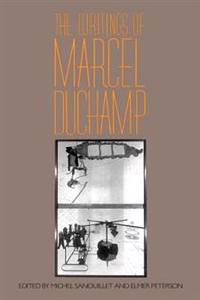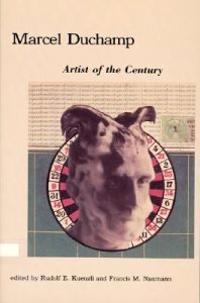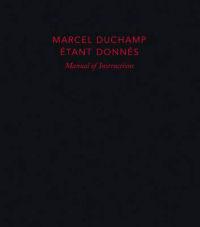Marchel Duchamp the Bachelor Stripped Bare (Inbunden)
avMarcel Duchamp, Alice Goldfarb Marquis, Marcel Duchamp
ISBN: 9780878466443 - UTGIVEN: 200209Marcel Duchamp (Pocket)
avMarcel Duchamp, Calvin Tomkins, Marcel Duchamp
ISBN: 9781936440399 - UTGIVEN: 201302In 1964, Calvin Tomkins spent a number of afternoons interviewing Marcel Duchamp in his apartment on West 10th Street in New York. Casual yet insightful, Duchamp reveals himself as a man and an artist whose playful principles toward living freed him to make art that was as unpredictable, complex, an[...]
Marcel Duchamp & Vitaly Halberstadt (Inbunden)
avMarcel (CON) Duchamp, Ernst Strouhal, Marcel (CON) Duchamp
ISBN: 9783869843278 - UTGIVEN: 2013-04In 1932, Marcel Duchamp published "Opposition and Sister Squares Are Reconciled," a collaboration with chess champion Vitaly Halberstadt on endgames in chess. Ernst Strouhal's illustrated study approaches this volume as an "almost utopian treatise on chess endgames" and as a trilingual artist's book[...]
The Writings of Marcel Duchamp (Häftad)
avMarcel Duchamp, Michel Sanouillet, Elmer Peterson
ISBN: 9780306803413 - UTGIVEN: 1989-03In the twenties, Surrealists proclaimed that words had stopped playing around and had begun to make love. Nowhere is this more apparent than in the writings of Marcel Duchamp, who fashioned some of the more joyous and ingenious couplings and uncouplings in modern art. This collection beings togethe[...]
Marcel Duchamp (Inbunden)
avMarcel (CON) Duchamp, Jeff Wall, Michael (INT) Taylor
ISBN: 9783869845005 - UTGIVEN: 2014-11Duchamp And/Or/In China (Häftad)
avPaula Tsai, Laura Tucker, Marcel Duchamp
ISBN: 9787510060137 - UTGIVEN: 2014-04"Duchamp and/or/in China" investigates the impact of Duchamp on contemporary Chinese art. It includes a pull-out section of his best-known works. Among the artists included here are Ai Weiwei, Cai Yuan + Xi Jian Jun, Huang Yong Ping, Zhao Zhao and Zheng Guogu.[...]
Marcel Duchamp på radio : Georges Charbonniers intervjuer med Marcel Duchamp i franska radion 1960-1961 (Häftad)
ISBN: 9789197050586 - UTGIVEN: 2009-04-01Sex radiointervjuer med Marcel Duchamp från 1960-61 om konsten, konstnärererna, historien, språket, readymades, dadaismen, surrealismen och konstmarknaden. Intervjuare: Georges Charbonnier, initierad kulturjournalist som bidrar med sina erfarenheter till ett spirituellt samtal.[...]
Duchamp And The Aesthetics Of Chance (Inbunden)
avHerbert Molderings
ISBN: 9780231147620 - UTGIVEN: 2010-05-10A study of frequently mis-read artist, Duchamp, translated by John Brogden.
Sprezzatura: Concealing the Effort of Art from Aristotle to Duchamp
ISBN: 9780231175821 - UTGIVEN: 2018-03The essence of art is to conceal art. A dancer or musician does not only need to perform with ability. There should also be a lack of visible effort that gives an impression of naturalness. To disguise technique and feign ease is to heighten beauty. To express this notion, Italian has a word with no[...]
Inventing Marcel Duchamp (Inbunden)
avAnne Collins (EDT) Goodyear, James W. (EDT) Mcmanus, Janine A. (CON) Mileaf
ISBN: 9780262013000 - UTGIVEN: 2009-04One of the most influential artists of the twentieth century, Marcel Duchamp (1887-1968) was a master of self-invention who carefully regulated the image he projected through self-portraiture and through his collaboration with those who portrayed him. During his long career, Duchamp recast accepted [...]
The Apparently Marginal Activities of Marcel Duchamp
ISBN: 9780262034821 - UTGIVEN: 2016-11This groundbreaking and richly illustrated book tells a new story of the twentieth century's most influential artist, recounted not so much through his artwork as through his "non-art" work. Marcel Duchamp is largely understood in critical and popular discourse in terms of the objects he produced, w[...]
The Exiles of Marcel Duchamp (Pocket)
avT. J. Demos
ISBN: 9780262518116 - UTGIVEN: 2012-09Marcel Duchamp was a famous expatriate, a wanderer, living and working in Paris, New York, and Buenos Aires and escaping from each in turn. But exile, argues T. J. Demos in this innovative reading, is more than a fact in Duchamp's biography. Exile--in the artist's own words, a "spirit of expatriatio[...]
Duchamp Effect, The (Pocket)
avMartha Buskirk, Mignon Nixon
ISBN: 9780262522175 - UTGIVEN: 1996-10-31Kant After Duchamp (Häftad)
avThierry de Duve
ISBN: 9780262540940 - UTGIVEN: 199804Kant after Duchamp brings together eight essays around a central thesis with many implications for the history of avant-gardes. Although Duchamp's readymades broke with all previously known styles, de Duve observes that he made the logic of modernist art practice the subject matter of his work, a sh[...]
Marcel Duchamp (Häftad)
avGeorge Baird
ISBN: 9780262610728 - UTGIVEN: 199106One hundred years after his birth, Marcel Duchamp remains an enigma; no other artist, perhaps, has produced so varied a group of masterpieces in so short a span of time. These eleven illustrated essays explore the structure and meaning of Duchamp's work as part of an ongoing critical enterprise that[...]
Etant Donnes (Inbunden)
avMarcel Duchamp, Anne D'Harnoncourt, Michael R. Taylor
ISBN: 9780300149807 - UTGIVEN: 200908Out of print for a number of years, this facsimile of Marcel Duchamp's "Manual of Instructions" was prepared by the artist for the disassembly of Etant donnes in his New York studio and its reassembly at the Philadelphia Museum of Art. First published more than twenty years ago, the manual has had f[...]
Dialogues with Marcel Duchamp (Häftad)
avPierre Cabanne
ISBN: 9780306803031 - UTGIVEN: 198708Marcel Duchamp, one of this centurys pioneer artists, moved his work through the retinal boundaries which had been established with impressionism into t field with impressionism into t field where language, thought and vision act upon one another, There it changed form through a complex interplay of[...]
Marcel Duchamp (Pocket)
avDawn Ades, Neil Cox, David Hopkins
ISBN: 9780500203224 - UTGIVEN: 1999-06Genius, anti-artist, charlatan, guru, imposter? Since 1914 Marcel Duchamp has been called all these. Arousing passion and controversy, he has exerted a great influence on art, whose very nature he challenged and redefined as concept rather than product by questioning its traditionally privileged opt[...]
The Duchamp Dictionary (Inbunden)
ISBN: 9780500239179 - UTGIVEN: 2014-04Marcel Duchamp (1887-1968) has entered mainstream culture as one of the founding fathers of modern art. Despite his popularity, books on Duchamp often shroud his work in theoretical and critical writing. Here, instead, is a book exploring the artist's life and work in a thoroughly new and engaging m[...]
Unpacking Duchamp: Art in Transit (Pocket)
avDalia Judovitz
ISBN: 9780520213760 - UTGIVEN: 1998-04-28Looking Askance: Skepticism and American Art from Eakins to Duchamp (Pocket)
avMichael Leja
ISBN: 9780520249967 - UTGIVEN: 2004-07-29Postmodernism and the En-Gendering of Marcel Duchamp (Pocket)
avAmelia Jones
ISBN: 9780521456548 - UTGIVEN: 1995-07A critical analysis of postmodernism in the visual arts since the 1960s, this book focuses primarily on American texts that reference and construct Marcel Duchamp as the originator of postmodern art. Amelia Jones contends that Duchamp, through his ?readymades?, (the standard terms used to describe D[...]
Duchamp in Context (Häftad)
avLinda Dalrymple Henderson
ISBN: 9780691123868 - UTGIVEN: 2005-09Between 1915 and 1923, Marcel Duchamp created one of the most mystifying art works of the early twentieth century: The Bride Stripped Bare by Her Bachelors, Even (also known as the Large Glass). The work is over nine feet tall, and on its glass surface Duchamp used such unorthodox materials as lead [...]
The Modern Art Invasion: Picasso, Duchamp, and the 1913 Armory Show That Scandalized America (Inbunden)
avElizabeth Lunday
ISBN: 9780762790173 - UTGIVEN: 2013-10In 1910 New York's art scene was dull and stuck in the past - lagging considerably behind Europe. Before the century reached its midpoint, however, New York would come to dominate the art world. It seemed that in a blink of an eye New York City tranformed from provincial backwater to vibrant epicent[...]

























